 .
.
Masking involves setting some of the pixel values in an image to zero, or some other "background" value. Masking can be done in one of two ways:
Note: you can also perform masking operations on individual slices or whole images in a similar way from the ROI Toolkit. There are three main differences:
If you use ROIs as a mask, you may also perform soft masking, to set the intensity of masked pixels not to the background value, but a value that depends on how much of an individual pixel is inside the mask.
Normally, pixels that are inside the mask do not have their pixel values changed: they are left at
the same intensity as the input image. However, you can also create images with binary intensity
values (either 0 outside the mask, or 1 inside the mask) by selecting
 .
.
Selecting Masker from the Process menu
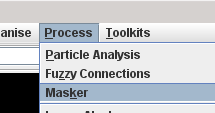 of
the main display frame brings up the Image Masking Tool:
of
the main display frame brings up the Image Masking Tool:
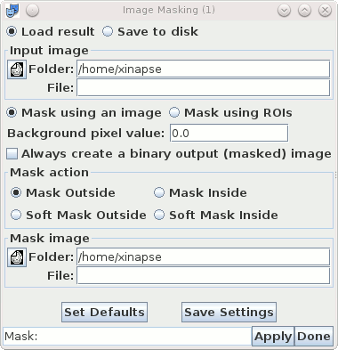
The Image Masking tool takes an input image, masks it, and produces a new image which is a copy of the input image, except that the new image will have its pixel intensity value set to zero (or some other chosen background intensity value) according to the mask and the masking operations performed. The new (masked) image can either be saved to disk, or loaded into Jim depending on your selection:

Load the input image and the mask image by clicking on the
 icon,
by typing in the folder (directory) and file name of the image, or by pressing the right mouse
button and selecting from the menu of recently-used images.
icon,
by typing in the folder (directory) and file name of the image, or by pressing the right mouse
button and selecting from the menu of recently-used images.

Next, set the background pixel value (which defaults to zero). Pixel intensities in the masked image that are affected by masking operations will have their intensity set to the background pixel intensity value.
Choose whether you want to set the pixels intensities outside the mask to the background, or those inside the mask to be the background, by clicking on the appropriate button:

If you are masking using ROIs, choose whether you want hard or soft masking.
Note: the selection of hard or soft masking has no impact when using an image mask.
Note: hard and soft masking only applies when you mask using ROIs. If
you mask using an image, soft masking behaves the same as hard masking.
If you want the output image to be a "binary" image (i.e., an image where the pixel intensities
are exclusively either zero or one) then select
Then, choose whether you will use an image as the mask, or a set of ROIs
by clicking the appropriate button:
Now click on the
Note: if the input image to be masked is a 4-D image (multiple 3-D
volumes) or an image with even higher dimensionality, then you can mask all the
3-D volumes within the input image using:
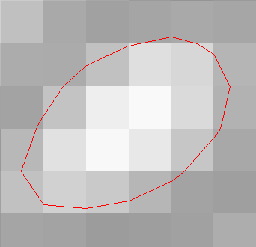
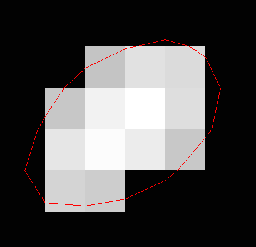
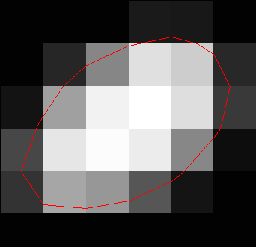
Before masking.
Hard masking.
Soft masking.
 .
.




The "XOR" mode is useful where you wish to define
regions of the image that have a "hole" in them. By having one
ROI inside another, the internal ROI then defines the hole in the image
when ROIs are combined using the XOR operation. Note, however, that you can also create
hollow ROIs to obtain a similar result.
Note: Mask action was set to "Mask Outside".
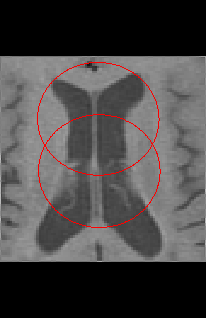
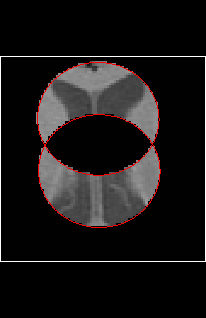
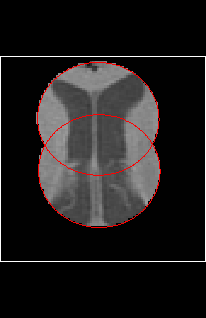
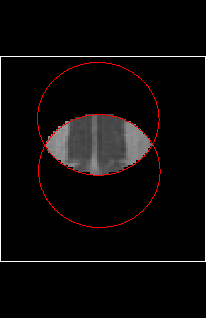
Before masking
XOR
Union
Intersection
 button to perform the
masking. If you have chosen to save the result to disk, then a
File Chooser will pop up, prompting you to choose a file name for
the new masked image. Otherwise, the result will be loaded into Jim.
button to perform the
masking. If you have chosen to save the result to disk, then a
File Chooser will pop up, prompting you to choose a file name for
the new masked image. Otherwise, the result will be loaded into Jim.